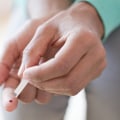If you have an active sore or blister, it may be important to get a swab test done in order to accurately diagnose the condition. A swab test can identify the virus responsible for causing the sore or blister and provide important information about its severity and the best course of action for treatment. In this article, you'll learn everything you need to know about swab tests for active sores or blisters, including what a swab test is, why it's important, and how to prepare for it.
Swab Test of an Active Sore or Blister
is a common diagnostic procedure used to test for active sores or blisters on the genital area. It is an effective way to diagnose genital herpes and other sexually transmitted infections (STIs).A swab test involves taking a sample from the affected area, usually with a cotton swab, and sending it off to a laboratory for further testing. The purpose of a swab test is to detect the presence of the herpes virus in the sore or blister. The procedure is relatively simple and involves taking a sample from the affected area and sending it off to a laboratory for analysis. The results of the swab test will indicate if there is an active herpes infection present in the sore or blister.
The swab test is usually performed by a doctor or healthcare professional. The sample is taken using a sterile cotton swab and placed into a tube or container for transport to the laboratory. The sample is then tested in the laboratory for the presence of herpes virus. Although the swab test is generally safe, there are some potential risks associated with it.
The most common risk is discomfort at the site where the sample was taken. There is also the potential for infection if the swab was contaminated or if the person performing the swab was not wearing gloves. The results of the swab test can be either positive or negative. A positive result indicates that there is an active herpes infection present in the sore or blister.
In this case, treatment should be started as soon as possible to reduce symptoms and prevent further spread of the virus. A negative result indicates that no active herpes infection is present in the sore or blister. Accurate diagnosis and treatment of genital herpes are important in order to reduce symptoms and prevent further spread of the virus. If left untreated, genital herpes can lead to serious complications including infertility, pelvic inflammatory disease, and even death in rare cases. Treatment options include antiviral medications, topical creams, and lifestyle changes.
Managing genital herpes symptoms can be challenging, but there are several things you can do to make living with this condition easier. It is important to practice good hygiene by washing your hands often and keeping the affected area clean and dry. Avoiding sexual contact when you have an active outbreak can help reduce the risk of spreading the virus to others. Eating a healthy diet, getting enough sleep, and exercising regularly can also help reduce symptoms.
How is a Swab Test Performed?
A swab test is a simple diagnostic procedure used to test for active sores or blisters on the genital area. It involves swabbing the affected area with a cotton-tipped swab and sending the specimen to a laboratory for analysis. The type of swab used depends on the type of sample being collected. Generally, a standard cotton-tipped swab is used, but other specialized swabs may be required for certain types of samples.The swab should be inserted into the affected area and rotated to collect a sample. To ensure accuracy, it is important to make sure that the swab is inserted to the appropriate depth and rotated thoroughly. The risks associated with a swab test are minimal. There may be some minor discomfort during the procedure, but it should not be overly painful.
Additionally, there is always a risk of infection when testing for STIs, but this can be minimized by following proper safety protocols. It is important to get accurate results from a swab test in order to diagnose and treat genital herpes correctly. Following these steps can help ensure accurate testing and results.
What is a Swab Test?
A swab test is a diagnostic procedure used to identify the presence of an infection, such as genital herpes, in the genital area. It involves collecting a sample of fluid or cells from the affected area using a swab, which is then tested in a laboratory for the presence of an infection. Swab tests are an effective way to diagnose active sores or blisters on the genital area, as they can accurately identify the cause of the infection.This type of testing is especially important for correctly diagnosing and treating sexually transmitted infections (STIs). In some cases, a swab test may be used to confirm that a patient has been cured of an infection. During the swab test, the doctor or nurse will use a sterile cotton swab to collect a sample from the sore or blister. The sample is then sent to a laboratory for analysis. The results can usually be available within 1-2 days.
Depending on the results of the swab test, the doctor may recommend further testing or treatment.
Swab test
, active sore, blister, genital herpes, sexually transmitted infectionWhat Do the Results Mean?
When a swab test is performed, the results may show a positive or a negative result. A positive result indicates that an active sore or blister is present on the genital area and that it is likely caused by the herpes virus. In this case, follow-up care and treatment is necessary to prevent further spread of the infection. Treatment typically involves prescription antiviral medications. A negative result means that there is no active sore or blister present.This may be due to either the infection being in remission or not being present at all. In either case, it is important to abstain from sexual contact until a definitive diagnosis can be made. When a swab test comes back with a positive result, it is important to seek prompt medical treatment. Antiviral medications can help reduce the severity and frequency of outbreaks, as well as reduce the risk of transmission to sexual partners. It is also important to practice safe sex and inform any potential sexual partners of your diagnosis. If a swab test comes back with a negative result, it does not necessarily mean that the infection is absent.
It could mean that the virus is not currently active and thus, not detectable by a swab test. In this case, follow-up testing may be necessary to make an accurate diagnosis. Additionally, it is important to practice safe sex and inform any potential sexual partners of your status.
The Importance of Accurate Diagnosis and Treatment
Accurate diagnosis and treatment of genital herpes is important in order to manage symptoms, reduce risk of transmission, and reduce risk of complications. Knowing the cause of the infection allows for more targeted treatment and can help prevent future outbreaks.Furthermore, seeking medical care allows people to take appropriate steps to reduce the risk of transmission to partners, such as using condoms and other forms of protection. For those with genital herpes, prompt diagnosis and treatment can help reduce the severity and frequency of outbreaks. Early diagnosis also allows for prescription medications that can reduce the duration and severity of outbreaks. In addition, antiviral medications can reduce the risk of transmitting the virus to a partner. While it is important to diagnose genital herpes accurately in order to receive effective treatment, it is also important to ensure that other possible causes for the infection are ruled out. This is particularly important for people who have experienced recurrent episodes or have multiple partners.
Other sexually transmitted infections (STIs) have similar symptoms to genital herpes and require different treatments. It is important to receive a comprehensive diagnosis in order to ensure that the right treatment plan is being used. In conclusion, it is important to get an accurate diagnosis and treatment for genital herpes in order to manage symptoms, reduce risk of transmission, and reduce risk of complications. Early diagnosis and treatment can help reduce the severity and frequency of outbreaks, as well as minimize the risk of transmission to partners. A swab test is an effective and reliable way to diagnose active sores or blisters on the genital area. It is important to get tested for active sores or blisters in order to diagnose and treat genital herpes and other STIs accurately.
To reduce the risk of transmission, practice safe sex and use condoms. Speak to your doctor if you have any questions or concerns about testing or treatment. By understanding what a swab test is, how it is performed, and what the results mean, you can better protect yourself against complications caused by genital herpes and other STIs.


